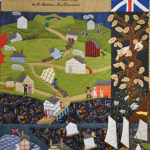Castine Community Bicentennial Quilt
The Castine Bicentennial Quilt, 1996, was designed and constructed by sixty members of the Castine community. It was presented to the Castine Historical Society in celebration of the town’s bicentennial in expectation that this community memorial be exhibited annually. The fabric mural, 24 feet wide, has become a favorite of local residents and visitors.
The Quilt is made up of seven squares that tell the history of Castine. These are separated by eight panels representing the native flora and fauna of the Maine Coast. Above each square is a brief embroidered synopsis of the history below. Above the panels are the flags that have flown over Castine throughout its long history. Below the panels and squares flows the water of the river and bay that has been so crucial to our history. Here too are all the watercraft, from Native American canoes to Maine Maritime Academy’s training ship, State of Maine.
Arched borders above and below symbolize the world and universe, bringing the entire quilt together and reminding us that we are part of a much greater whole.
For an in-depth description of the quilt and its creation, please click HERE.
From left to right:
- Square One
- Square Two
- Square Three
- Square Four
- Square Five
- Square Six
- Square Seven
Square one: The Abenakis who lived here long before Europeans arrived; growing corn, chopping wood, cooking fish. The scene includes a missionary priest at the French Fort Pentagoet, and depicts the amicable relations between the two cultures as the Baron proposes to Mathilda, Madockawando’s daughter.
Square two: English colonial life at the edge of the wilderness, and the Penobscot Expedition of 1779. The colonists’ small Defiance is one of the many vessels fighting the British warships. Behind the flying cannonballs are men climbing the cliffs at Blockhouse Point.
Square three: More colonial life, with chickens and cows; Fort George is at the head of the main street, built by the British to fight the Revolution. The Loyalists of Castine move to New Brunswick, houses and all in 1789.
Square four: The centerpiece of the quilt with goods coming and going to the customs house. Several important commercial ships are represented here, like the Liverpool and Cadiz.
Square five: Castine’s heyday of 19th century industry: a ropewalk, salt shed, brickyard, blacksmith, shipyard, and chandlery.
Square six: The late 19th and early 20th centuries find Castine a “watering hole,” with ladies playing croquet in front of the Acadian Hotel. There is the old Brooksville ferry, fishing on the bank of the river, and the life that supported the recreation: a livery stable, and ladies going to work at the sardine factory.
Square seven: Modern times in Castine: a recycling truck, roadwork, school bus, church, and a jogger (said to represent super quilter Charleen Wiseman!)
The Ships: Running from left to right, include: Abenaki canoes, British ships, the frigate Warren, (flagship of the colonists during the Penobscot Expedition), barges carrying the Loyalist houses to Canada, the Eight Sisters, the Liverpool, working boats of the 19th Century, the J.P. Whitney, the steamer Goldenrod, Eaton’s Boatyard’s the Annabelle, the Schooner Bowdoin, MMA’s State of Maine, the tug Pentagoet. Mace Eaton’s Castine Class sailboats and a host of paddlers in kayaks finish off the 20th century.
—Excerpted from a pamphlet compiled and produced for the CHS by Deborah Pulliam, August 1997








